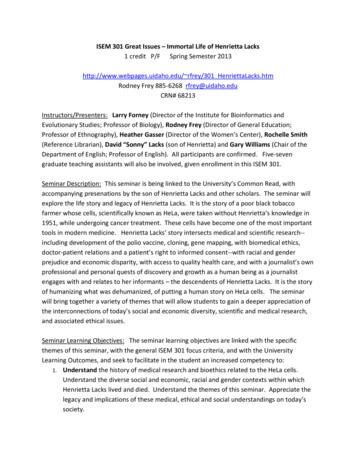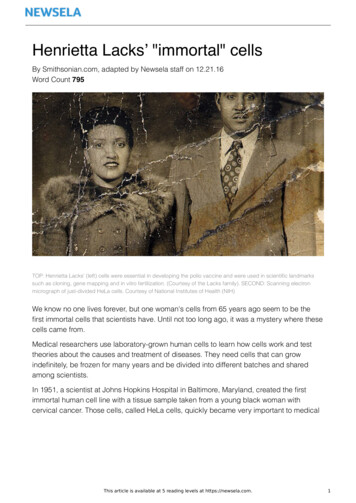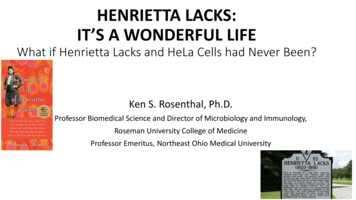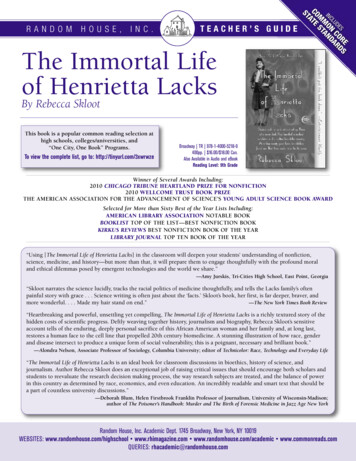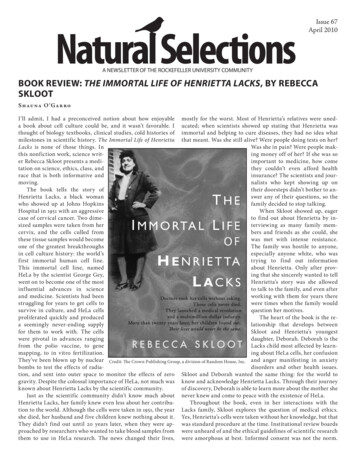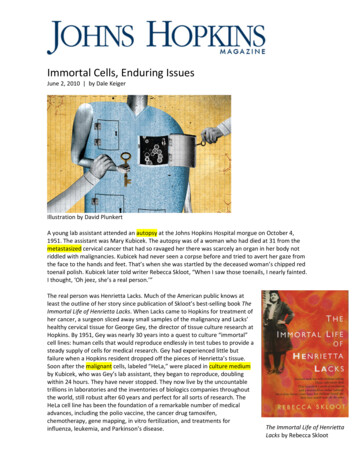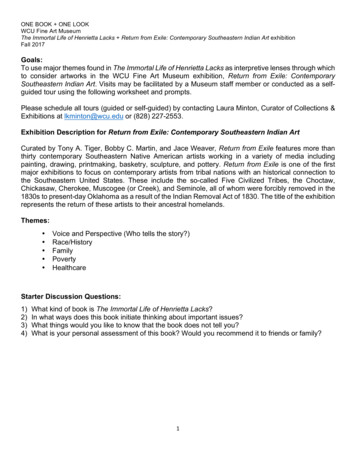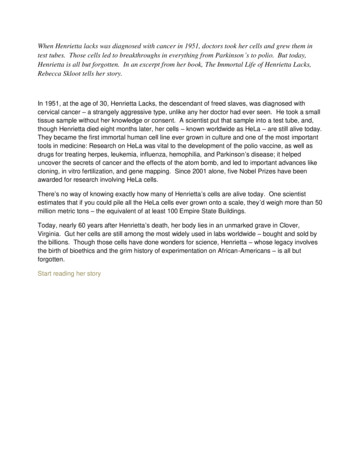
Transcription
When Henrietta lacks was diagnosed with cancer in 1951, doctors took her cells and grew them intest tubes. Those cells led to breakthroughs in everything from Parkinson’s to polio. But today,Henrietta is all but forgotten. In an excerpt from her book, The Immortal Life of Henrietta Lacks,Rebecca Skloot tells her story.In 1951, at the age of 30, Henrietta Lacks, the descendant of freed slaves, was diagnosed withcervical cancer – a strangely aggressive type, unlike any her doctor had ever seen. He took a smalltissue sample without her knowledge or consent. A scientist put that sample into a test tube, and,though Henrietta died eight months later, her cells – known worldwide as HeLa – are still alive today.They became the first immortal human cell line ever grown in culture and one of the most importanttools in medicine: Research on HeLa was vital to the development of the polio vaccine, as well asdrugs for treating herpes, leukemia, influenza, hemophilia, and Parkinson’s disease; it helpeduncover the secrets of cancer and the effects of the atom bomb, and led to important advances likecloning, in vitro fertilization, and gene mapping. Since 2001 alone, five Nobel Prizes have beenawarded for research involving HeLa cells.There’s no way of knowing exactly how many of Henrietta’s cells are alive today. One scientistestimates that if you could pile all the HeLa cells ever grown onto a scale, they’d weigh more than 50million metric tons – the equivalent of at least 100 Empire State Buildings.Today, nearly 60 years after Henrietta’s death, her body lies in an unmarked grave in Clover,Virginia. Gut her cells are still among the most widely used in labs worldwide – bought and sold bythe billions. Though those cells have done wonders for science, Henrietta – whose legacy involvesthe birth of bioethics and the grim history of experimentation on African-Americans – is all butforgotten.Start reading her story
most famous clinical gynecology textbooks, which is still widely usedsixty years and ten editions after he first wrote it. His reputation wasinternational: when the king of Morocco's wife fell ill, he insisted onlyTeLinde could operate on her. By 1951, when Henrietta arrived atHopkins, TeLinde had developed a theory about cervical cancer that,if correct, could save the lives of millions of women. But few in thefield believed him.Cervical carcinomas are divided into two types:invasive carcinomas, which have penetrated the surface of the cervix,and noninvasive carcinomas, which haven't. The noninvasive typeis sometimes called "sugar-icing carcinoma," because it grows in a .smooth layered sheet across the surface of the cervix, but its officialname is carcinoma in situ, which derives from the Latin for "cancer inits original place."In 195I , most doctors in the field believed that invasive carcinomawas deadly, and carcinoma in situ wasn't. So they treated the invasivetype aggressively but generally didn't worry about carcinoma in situbecause they thought it couldn't spread. TeLinde disagreed-he believed carcinoma in situ was simply an early stage of invasive carcinoma that, if left untreated, eventually became deadly. So he treated itaggressively, often removing the cervix, uterus, and most of the vagina.H e argued that this would drastically reduce cervical cancer deaths,but his critics called it extreme and unnecessary.Diagnosing carcinoma in situ had only been possible since 1941,when George Papanicolaou, a Greek researcher, published a paper describing a test he'd developed, now called the Pap smear. It involvedscraping cells from the cervix with a curved glass pipette and examining them under a microscope for precancerous changes that TeLindeand a few others had identified years earlier. This was a tremendousadvance, because those precancerous cells weren't detectable otherwise: they caused no physical symptoms and weren't palpable or vis-
Diagnosis and Treatment29ible to the naked eye. By the time a woman began showing symptoms,there was little hope of a cure. But with the Pap smear, doctors coulddetect precancerous cells and perform a hysterectomy, and cervicalcancer would be almost entirely preventable.At that point, more than 15,000 women were dying each yearfrom cervical cancer. The Pap smear had the potential to decreasethat death rate by 70 percent or more, but there were two thingsstanding in its way: first, many women-like Henrietta-simplydidn't get the test; and, second, even when they did, few doctorsknew how to interpret the results accurately, because they didn'tknow what the various stages of cervical cancer looked like undera microscope. Some mistook cervical infections for cancer and removed a woman's entire reproductive tract when all she needed wasantibiotics. Others mistook malignant changes for infection, sendingwomen home with antibiotics only to have them return later, dyingfrom metastasized cancer. And even when doctors correctly diagnosedprecancerous changes, they often didn't know how those changesshould be treated.TeLinde set out to minimize what he called "unjustifiable hysterectomies" by documenting what wasn't cervical cancer and by urgingsurgeons to verify smear results with biopsies before operating. H ealso hoped to prove that women with carcinoma in situ needed aggressive treatment, so their cancer didn't become invasive.Not long before Henrietta's first exam, TeLinde presented hisargument about carcinoma in situ to a major meeting of pathologistsin Washington, D.C., and the audience heckled him off the stage. Sohe went back to Hopkins and planned a study that would prove themwrong: he and his staff would review all medical records and biopsiesfrom patients who'd been diagnosed with invasive cervical cancer atHopkins in the past decade, to see how many initially had carcinomain situ.Like many doctors of his era, TeLinde often used patients fromthe public wards for research, usually without their knowledge. Many
scientists believed that since patients were treated for free in the public wards, it was fair to use them as research subjects as a form of payment. And as Howard Jones once wrote, "Hopkins, with its largeindigent black population, had no dearth of clinical material."In this particular study -the largest ever done on the relationshipbetween the two cervical cancers-Jones and TeLinde found that62 percent of women with invasive cancer who'd had earlier biopsiesfirst had carcinoma in situ. In addition to that study, TeLinde thought,if he could find a way to grow living samples from normal cervicaltissue and both types of cancerous tissue-something never donebefore-he could compare all three. If he could prove that carcinomain situ and invasive carcinoma looked and behaved similarly in thelaboratory, he could end the debate, showing that he'd been right allalong, and doctors who ignored him were killing their patients. So hecalled George Gey (pronounced Guy),head of tissue culture researchat Hopkins.Gey and his wife, Margaret, had spent the last three decadesworking to grow malignant cells outside the body, hoping to use themto find cancer's cause and cure. But most cells died quickly, and thefew that survived hardly grew at all. The Geys were determined togrow the first immortal human cells: a continuously dividing line ofcells all descended from one original sample, cells that would constantly replenish themselves and never die. Eight years earlier-in1943-a group of researchers at the National Institutes of Health hadproven such a thing was possible using mouse cells. The Geys wantedto grow the human equivalent-they didn't care what kind of tissuethey used, as long as it came from a person.Gey took any cells he could get his hands on-he called himself"the world's most famous vulture, feeding on human specimens almostconstantly." So when TeLinde offered him a supply of cervical cancertissue in exchange for trying to grow some cells, Gey didn't hesitate.And TeLinde began collecting samples from any woman who happened to walk into Hopkins with cervical cancer. Including Henrietta.
Diagnosis and Treatment3IO n February 5 , 1951,after Jones got Henrietta'sbiopsy report back from the lab, he called and told her it was malignant. Henrietta didn't tell anyone what Jones said, and no one asked.She simply went on with her day as if nothing had happened, whichwas just like her-no sense upsetting anyone over something she coulddeal with herself.That night Henrietta told her husband, "Day, I need to go backto the doctor tomorrow. He wants to do some tests, give me somemedicine." The next morning she climbed from the Buick outsideHopkins again, telling Day and the children not to worry."Ain't nothin serious wrong," she said. "Doctor's gonna fix meright up."Henrietta went straight to the admissions desk and told the receptionist she was there for her treatment. Then she signed a form withthe words OPERATION PERMIT at the top of the page. It said:I hereby give consent to the staff of The Johns HopkinsHospital to perform any operative procedures and underany anaesthetic either local or general that they maydeem necessary in the proper surgical care andtreatment of:Henrietta printed her name in the blank space. A witness with illegiblehandwriting signed a line at the bottom of the form, and Henriettasigned another.Then she followed a nurse down a long hallway into the ward forcolored women, where Howard Jones and several other white physicians ran more tests than she'd had in her entire life. They checked herurine, her blood, her lungs. They stuck tubes in her bladder and nose.O n her second night at the hospital, the nurse on duty fed Henrietta an early dinner so her stomach would be empty the next morning,when a doctor put her under anesthetic for her first cancer treatment.Henrietta's tumor was the invasive type, and like hospitals nationwide,
Hopkins treated all invasive cervical carcinomas with radium, a whiteradioactive metal that glows an eerie blue.When radium was first discovered in the late 18oos, headlines nationwide hailed it as "a substitute for gas, electricity, and a positivecure for every disease." Watchmakers added it to paint to make watchdials glow, and doctors administered it in powdered form to treateverything from seasickness to ear infections. But radium destroysany cells it encounters, and patients who'd taken it for trivial problems began dying. Radium causes mutations that can turn into cancer,and at high doses it can burn the skin off a person's body. But it alsokills cancer cells.Hopkins had been using radium to treat cervical cancer since theearly 19oos, when a surgeon named Howard Kelly visited Marie andPierre Curie, the couple in France who'd discovered radium and itsability to destroy cancer cells. Without realizing the danger of contactwith radium, Kelly brought some back to the United States in his pockS ,ets and regularly traveled the world collecting more. By the I O several studies-one of them conducted by Howard Jones, Henrietta'sphysician-showed that radium was safer and more effective than surgery for treating invasive cervical cancer.The morning of Henrietta's first treatment, a taxi driver picked upa doctor's bag filled with thin glass tubes of radium from a clinicacross town. The tubes were tucked into individual slots inside smallcanvas pouches hand-sewn by a local Baltimore woman. The poucheswere called Brack plaques, after the Hopkins doctor who inventedthem and oversaw Henrietta's radium treatment. He would later dieof cancer, most likely caused by his regular exposure to radium, aswould a resident who traveled with Kelly and also transported radiumin his pockets.One nurse placed the Brack plaques on a stainless-steel tray. Another wheeled Henrietta into the small colored-only operating roomon the second floor, with stainless-steel tables, huge glaring lights, andan all-white medical staff dressed in white gowns, hats, masks, andgloves.
Diagnosis and Treatmentj3With Henrietta unconscious on the operating table in the centerof the room, her feet in stirrups, the surgeon on duty, Dr. LawrenceWharton Jr., sat on a stool between her legs. He peered inside Henrietta, dilated her cervix, and prepared to treat her tumor. But firstthough no one had told Henrietta that TeLinde was collecting samplesor asked if she wanted to be a donor-Wharton picked up a sharpknife and shaved two dime-sized pieces of tissue from Henrietta'scervix: one from her tumor, and one from the healthy cervical tissuenearby. Then he placed the samples in a glass dish.Wharton slipped a tube filled with radium inside Henrietta's cervix, and sewed it in place. H e sewed a plaque filled with radium to theouter surface of her cervix and packed another plaque against it. H eslid several rolls of gauze inside her vagina to help keep the radium inplace, then threaded a catheter into her bladder so she could urinatewithout disturbing the treatment.When Wharton finished, a nurse wheeled Henrietta back into theward, and Wharton wrote in her chart, "The patient tolerated the procedure well and left the operating room in good condition." O n a separate page he wrote, "Henrietta Lacks . . . Biopsy of cervical tissue. . .Tissue given to Dr. George Gey."A resident took the dish with the samples to Gey's lab, as he'ddone many times before. Gey still got excited at moments like this,but everyone else in his lab saw Henrietta's sample as somethingtedious-the latest of what felt like countless samples that scientistsand lab technicians had been trying and failing to grow for years. Theywere sure Henrietta's cells would die just like all the others.
The Birth of HeLa35while she ate, just as she was doing when Gey walked into the labcarrying the pieces of Henrietta's cervix."I'm putting a new sample in your cubicle," he told her.Mary pretended not to notice. Not again, she thought, and kepteating her sandwich. It can wait till I'm done.Mary knew she shouldn't wait-every moment those cells sat inthe dish made it more likely they'd die. But she was tired of cell culture, tired of meticulously cutting away dead tissue like gristle from asteak, tired of having cells die after hours of work.Why bother? she thought.G e y hired Mary for her hands. She was freshout of college with a physiology degree when her adviser sent her foran interview. Gey asked Mary to pick up a pen from the table andwrite a few sentences. Now pick up that knife, he said. Cut this pieceof paper. Twirl this pipette.Mary didn't realize until months later that he'd been studying herhands, checking their dexterity and strength to see how they'd standup to hours of delicate cutting, scraping, tweezing, and pipetting.By the time Henrietta walked into Hopkins, Mary was handlingmost of the tissue samples that came through the door, and so far allsamples from TeLinde's patients had died.At that point, there were many obstacles to growing cells successfully. For starters, no one knew exactly what nutrients they needed tosurvive, or how best to supply them. Many researchers, including theGeys, had been trying for years to develop the perfect culturemedium-the liquid used for feeding cells. The recipes for Gey Culture Medium evolved constantly as George and Margaret added andremoved ingredients, searching for the perfect balance. But they allsounded like witches' brews: the plasma of chickens, purCe of calffetuses, special salts, and blood from human umbilical cords. Georgehad rigged a bell and cable from the window of his lab across a courtyard to the Hopkins maternity ward, so nurses could ring anytime a
baby was born, and Margaret or Mary would run over and collectumbilical cord blood.The other ingredients weren't so easy to come by: George visitedlocal slaughterhouses at least once a week to collect cow fetuses andchicken blood. He'd drive there in his rusted-out old Chevy, its leftfender flapping against the pavement, shooting sparks. Well beforedawn, in a rundown wooden building with a sawdust floor and widegaps in the walls, Gey would grab a screaming chicken by the legs,yank it upside down from its cage, and wrestle it to its back on abutcher block. He'd hold its feet in one hand and pin its neck motionless to the wood with his elbow. With his free hand, he'd squirt thebird's chest with alcohol, and plunge a syringe needle into the chicken's heart to draw blood. Then he'd stand the bird upright, saying,"Sorry, old fella," and put it back in its cage. Every once in a while,when a chicken dropped dead from the stress, George took it home soMargaret could fry it for dinner.Like many procedures in their lab, the Gey Chicken BleedingTechnique was Margaret's creation. She worked out the method stepby-step, taught it to George, and wrote detailed instructions for themany other researchers who wanted to learn it.Finding the perfect medium was an ongoing experiment, but thebiggest problem facing cell culture was contamination. Bacteria and ahost of other microorganisms could find their way into cultures frompeople's unwashed hands, their breath, and dust particles floatingthrough the air, and destroy them. But Margaret had been trained as asurgical nurse, which meant sterility was her specialty-it was key topreventing deadly infections in patients in the operating room. Manywould later say that Margaret's surgical training was the only reasonthe Gey lab was able to grow cells at all. Most culturists, like George,were biologists; they knew nothing about preventing contamination.Margaret taught George everything he knew about keeping cultures sterile, and she did the same with every technician, grad student,and scientist who came to work or study in the lab. She hired a localwoman named Minnie whose sole job was washing the laboratory
The Birth of HeLa37glassware using the only product Margaret would allow: Gold DustTwins soap. Margaret was so serious about that soap, when she hearda rumor that the company might go out of business, she bought an entire boxcar full of it.Margaret patrolled the lab, arms crossed, and leaned over Minnie'sshoulder as she worked, towering nearly a foot above her. If Margaretever smiled, no one could have seen it through her ever-present surgical mask. She inspected all the glassware for spots or smudges, andwhen she found them-which was often-she'd scream, "MINNIE!"so loud that Mary cringed.Mary followed Margaret's sterilizing rules meticulously to avoidher wrath. After finishing her lunch, and before touching Henrietta'ssample, Mary covered herself with a clean white gown, surgical cap,and mask, and then walked to her cubicle, one of four airtight roomsGeorge had built by hand in the center of the lab. The cubicles weresmall, only five feet in any direction, with doors that sealed like afreezer's to prevent contaminated air from getting inside. Mary turnedon the sterilizing system and watched from outside as her cubicle filledwith hot steam to kill anything that might damage the cells. When thesteam cleared, she stepped inside and sealed the door behind her, thenhosed the cubicle's cement floor with water and scoured her workbench with alcohol. The air inside was filtered and piped in through avent on the ceiling. Once she'd sterilized the cubicle, she lit a Bunsenburner and used its flame to sterilize test tubes and a used scalpelblade, since the Gey lab couldn't afford new ones for each sample.Only then did she pick up the pieces of Henrietta's cervixforceps in one hand, scalpel in the other-and carefully slice them intoone-millimeter squares. She sucked each square into a pipette, anddropped them one at a time onto chicken-blood clots she'd placed atthe bottom of dozens of test tubes. She covered each clot with severaldrops of culture medium, plugged the tubes with rubber stoppers, andlabeled each one as she'd labeled most cultures they grew: using thefirst two letters of the patient's first and last names.After writing "HeLa," for Henrietta and Lacks, in big black letters
on the side of each tube, Mary carried them to the incubator roomthat Gey had built just like he'd built everything else in the lab: byhand and mostly from junkyard scraps, a skill he'd learned from a lifetime of making do with nothing.George Gey was born in 1899 and raised on aPittsburgh hillside overlooking a steel mill. Soot from the smokestacks made his parents' small white house look like it had been permanently charred by fire and left the afternoon sky dark. His motherworked the garden and fed her family from nothing but the food sheraised. As a child, George dug a small coal mine in the hill behind hisparents' house. He'd crawl through the damp tunnel each morningwith a pick, filling buckets for his family and neighbors so they couldkeep their houses warm and stoves burning.Gey paid his way through a biology degree at the University ofPittsburgh by working as a carpenter and mason, and he could makenearly anything for cheap or free. During his second year in medicalschool, he rigged a microscope with a time-lapse motion picture camera to capture live cells on film. It was a Frankensteinish mishmashof microscope parts, glass, and 16-millimeter camera equipment fromwho knows where, plus metal scraps, and old motors from Shapiro's junkyard. He built it in a hole he'd blasted in the foundation ofHopkins, right below the morgue, its base entirely underground andsurrounded by a thick wall of cork to keep it from jiggling whenstreetcars passed. At night, a Lithuanian lab assistant slept next to thecamera on a cot, listening to its constant tick, making sure it stayedstable through the night, waking every hour to refocus it. With thatcamera, Gey and his mentor, Warren Lewis, filmed the growth ofcells, a process so slow-like the growth of a flower-the naked eyecouldn't see it. They played the film at high speed so they could watchcell division on the screen in one smooth motion, like a story unfolding in a flip book.It took Gey eight years to get through medical school because he
The Birth of HeLa39kept dropping out to work construction and save for another year'stuition. After he graduated, he and Margaret built their first lab in ajanitor's quarters at Hopkins-they spent weeks wiring, painting,plumbing, building counters and cabinets, paying for much of it withtheir own money.Margaret was cautious and stable, the backbone of the lab. Georgewas an enormous, mischievous, grown-up kid. At work he was dapper, but at home he lived in flannels, khakis, and suspenders. H emoved boulders around his yard on weekends, ate twelve ears of cornin one sitting, and kept barrels full of oysters in his garage so he couldshuck and eat them anytime he wanted. He had the body of a retiredlinebacker, six feet four inches tall and 2 1 5 pounds, his back unnaturally stiff and upright from having his spine fused so he'd stop throwing it out. When his basement wine-making factory exploded on aSunday, sending a flood of sparkling burgundy through his garage andinto the street, Gey just washed the wine into a storm drain, waving athis neighbors as they walked to church.Gey was a reckless visionary-spontaneous, quick to start dozens of projects at once, filling the lab and his basement at home withhalf-built machines, partial discoveries, and piles of junkyard scrapsonly he could imagine using in a lab. Whenever an idea hit him, hesat wherever he was-at his desk, kitchen table, a bar, or behind thewheel of his car-gnawing on his ever-present cigar and scribblingdiagrams on napkins or the backs of torn-off bottle labels. That's howhe came up with the roller-tube culturing technique, his most important invention.It involved a large wooden roller drum, a cylinder with holes forspecial test tubes called roller tubes. The drum, which Gey called the"whirligig," turned like a cement mixer twenty-four hours a day, rotating so slowly it made only two full turns an hour, sometimes less.For Gey, the rotation was crucial: he believed that culture mediumneeded to be in constant motion, like blood and fluids in the body,which flow around cells, transporting waste and nutrients.When Mary finally finished cutting the samples of Henrietta's
cervix and dropping them in dozens of roller tubes, she walked intothe incubator room, slid the tubes one at a time into the drum, andturned it on. Then she watched as Gey's machine began churningslowly.Henrietta spent the next two days in the hospital, recovering from her first radium treatment. Doctors examinedher inside and out, pressing on her stomach, inserting new cathetersinto her bladder, fingers into her vagina and anus, needles into herveins. They wrote notes in her chart saying, "30 year-old coloredfemale lying quietly in no evident distress," and "Patient feels quitewell tonight. Morale is good and she is ready to go home."Before Henrietta left the hospital, a doctor put her feet in the stirrups again and removed the radium. He sent her home with instructions to call the clinic if she had problems, and to come back for asecond dose of radium in two and a half weeks.Meanwhile, each morning after putting Henrietta's cells in culture,Mary started her days with the usual sterilization drill. She peeredinto the tubes, laughing to herself and thinking, Nothing's happening.Big stcrprise. Then, two days after Henrietta went home from the hospital, Mary saw what looked like little rings of fried egg white aroundthe clots at the bottoms of each tube. The cells were growing, butMary didn't think much of it-other cells had survived for a while inthe lab.But Henrietta's cells weren't merely surviving, they were growingwith mythological intensity. By the next morning they'd doubled.Mary divided the contents of each tube into two, giving them roomto grow, and within twenty-four hours, they'd doubled again. Soonshe was dividing them into four tubes, then six. Henrietta's cells grewto fill as much space as Mary gave them.Still, Gey wasn't ready to celebrate. "The cells could die anyminute," he told Mary.But they didn't. They kept growing like nothing anyone had seen,
The Birth of HeLa4Idoubling their numbers every twenty-four hours, stacking hundreds ontop of hundreds, accumulatingby the millions. "Spreading like crabgrass!"Margaret said. They grew twenty times faster than Henrietta's normalcells, which died only a few days after Mary put them in culture. Aslong as they had food and warmth, Henrietta's cancer cells seemedunstoppable.Soon, George told a few of his closest colleagues that he thoughthis lab might have grown the first immortal human cells.ToAnd George said yes.
Henrietta is all but forgotten. In an excerpt from her book, The Immortal Life of Henrietta Lacks, Rebecca Skloot tells her story. In 1951, at the age of 30, Henrietta Lacks, the descendant of freed slaves, was diagnosed with cervical cancer - a strangely aggressive type, unlike any her doctor had ever seen. He took a small


